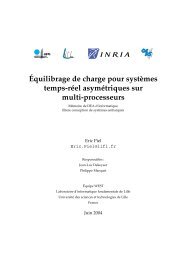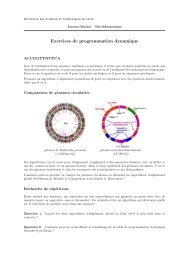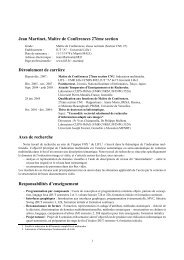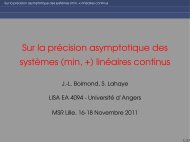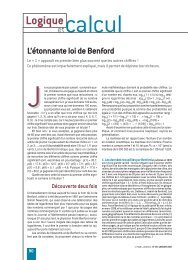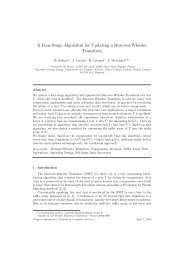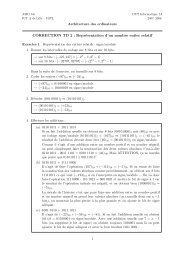Algorithmes de prediction et de recherche de multi-structures d'ARN
Algorithmes de prediction et de recherche de multi-structures d'ARN
Algorithmes de prediction et de recherche de multi-structures d'ARN
Create successful ePaper yourself
Turn your PDF publications into a flip-book with our unique Google optimized e-Paper software.
40 Chapter 3. Regliss – Locally optimal <strong>structures</strong> <strong>prediction</strong><br />
pairs of positions i and j are useful for the computation of locally optimal secondary <strong>structures</strong>:<br />
We only need MJ(x + 1, y − 1) for all base pairs (x, y) of BP, and intermediate values necessary<br />
to obtain MJ(x + 1, y − 1). So we should only consi<strong>de</strong>r pairs of positions of the form (k, y − 1)<br />
with x < k < y and (x, y) in BP. In practice, this reduces the search space and running time.<br />
The last point that we want to make here is that in the rule (3b), Filter(b, MJ(i, j)) can be<br />
computed efficiently. For this purpose, we show the following Lemma.<br />
Lemma 1 Given a structure S in MJ(i, j), l<strong>et</strong> b ′ be the first base pair of S not nested in b. S<br />
belongs to Filter(b, MJ(i, j)) if, and only if, such a b ′ exists and is conflicting with b.<br />
Proof.<br />
– If b ′ does not exist, then by <strong>de</strong>finition, S does not belong to Filter(b, MJ(i, j)).<br />
– If b ′ exists and is conflicting with b, then by <strong>de</strong>finition S belongs to Filter(b, MJ(i, j)).<br />
– If b ′ exists and is not conflicting with b, then no element of S is conflicting with b. In<strong>de</strong>ed, in this<br />
case, b ′ is juxtaposed with b. This implies that all base pairs greater than b ′ are juxtaposed with b. By<br />
construction of b ′ , we also know that all base pairs smaller that b ′ are not conflicting with b. So S does<br />
not belong to Filter(b, MJ(i, j)).<br />
With this Lemma, if b = (x, y), the computation of Filter(b, MJ(i, j)) requires at most<br />
O(y − x) tests for every structure S ∈ MJ(i, j).<br />
3.2.3 Construction of locally optimal secondary <strong>structures</strong><br />
We now explain how to compute the s<strong>et</strong> of locally optimal secondary <strong>structures</strong> from the s<strong>et</strong> of<br />
<strong>structures</strong> maximal for juxtaposition. The stepping stone is Theorem 1, stated in Section 3.2.1.<br />
The proof of this Theorem comes from the two following lemmas.<br />
Lemma 2 L<strong>et</strong> S be a locally optimal secondary structure on BP. Then we have the two following<br />
properties.<br />
(i) toplevel(S) is maximal for juxtaposition on BP[1..n],<br />
(ii) for each (x, y) in S, nested(x, y, S) is maximal for juxtaposition on BP[x + 1..y − 1].<br />
Proof.<br />
(i) Assume that toplevel(S) is not in MJ(1, n): It means that there exists a base pair b in BP −<br />
toplevel(S) such that {b} ∪ toplevel(S) is a secondary structure and b is not nested in any base pair<br />
of toplevel(S). The latter point implies that b is not in S. So {b} ∪ S is a secondary structure on BP<br />
that is a strict extension of S. This contradicts the hypothesis that S is locally optimal.<br />
(ii) Assume there exists (x, y) in S such that nested(x, y, S) is not maximal for juxtaposition on<br />
BP[x + 1..y − 1]. By Definition 5, this implies that there exists a base pair b in BP[x + 1..y − 1] −<br />
nested(x, y, S) such that {b} ∪ nested(x, y, S) is a secondary structure and b is not nested in any base<br />
pair of nested(x, y, S). Again, it follows that {b} ∪ S is a secondary structure on BP that is a strict<br />
extension of S, which contradicts the hypothesis that S is locally optimal.<br />
Conversely, each assembly of <strong>structures</strong> maximal for juxtaposition leads to a locally optimal<br />
secondary structure.





